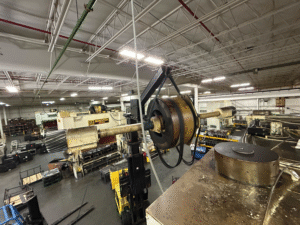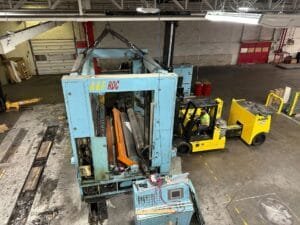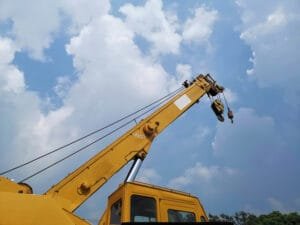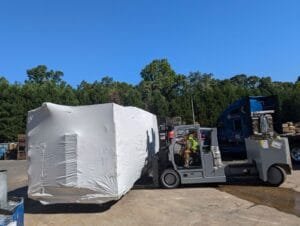Heavy equipment moving is a complex operation that requires meticulous planning, precise execution, and a deep understanding of various factors that can affect the process. One of the most significant and unpredictable factors is the weather. Weather conditions can drastically impact the safety, efficiency, and cost of moving heavy equipment. This article explores the various ways weather influences heavy equipment moves, the challenges it presents, and strategies to mitigate these challenges.
Understanding the Role of Weather in Heavy Equipment Moves
Weather conditions can affect every aspect of heavy equipment moving, from the initial planning stages to the final delivery. Here are some key weather-related factors to consider:
- Temperature: Extreme temperatures, both hot and cold, can impact the performance of machinery and the safety of workers.
- Precipitation: Rain, snow, and ice can create hazardous conditions for transporting and handling heavy equipment.
- Wind: High winds can affect the stability and control of equipment during the move.
- Visibility: Fog, heavy rain, or snow can reduce visibility, making it difficult to navigate and increasing the risk of accidents.
- Ground Conditions: Weather affects the ground conditions, which can influence the ease of movement and stability of heavy equipment.
Temperature Extremes
Temperature extremes pose significant challenges for heavy equipment moves. Both high and low temperatures can affect machinery performance, materials, and worker safety.
High Temperatures:
- Equipment Overheating: High temperatures can cause engines and hydraulic systems to overheat, leading to potential breakdowns and delays.
- Material Expansion: Metal components may expand in extreme heat, potentially causing mechanical issues or difficulties in assembly and disassembly.
- Worker Safety: Prolonged exposure to high temperatures can result in heat exhaustion or heat stroke for workers, necessitating frequent breaks and hydration.
Low Temperatures:
- Cold Start Issues: Cold temperatures can make it difficult to start engines and other machinery, particularly diesel engines.
- Brittle Materials: Some materials can become brittle in cold weather, increasing the risk of breakage.
- Worker Safety: Workers are at risk of frostbite and hypothermia in extremely cold conditions, requiring appropriate clothing and precautions.
Precipitation
Rain, snow, and ice can create significant challenges for heavy equipment moves, impacting both the machinery and the safety of the operation.
Rain:
- Slippery Surfaces: Wet surfaces can become slippery, increasing the risk of accidents and making it difficult to maneuver equipment.
- Mud and Soft Ground: Prolonged rain can soften the ground, making it challenging for heavy equipment to traverse without getting stuck.
- Visibility: Heavy rain can reduce visibility, making navigation difficult and increasing the risk of collisions.
Snow and Ice:
- Reduced Traction: Snow and ice significantly reduce traction, making it difficult to control and maneuver heavy equipment.
- Weight Considerations: Snow accumulation can add weight to equipment, potentially affecting balance and stability.
- Visibility: Snowfall and ice on windshields can impair visibility, increasing the likelihood of accidents.
Wind
Wind can have a substantial impact on the stability and safety of heavy equipment moves, especially for tall or wide loads.
High Winds:
- Stability Issues: High winds can destabilize tall or large equipment, increasing the risk of tipping over.
- Control Challenges: Wind can make it difficult to control equipment, especially during lifting and transport.
- Safety Hazards: Loose debris and other hazards can be blown into the path of moving equipment, posing additional risks.
Visibility
Good visibility is crucial for the safe and efficient movement of heavy equipment. Adverse weather conditions can significantly reduce visibility, posing risks to the operation.
Fog:
- Reduced Visibility: Fog can drastically reduce visibility, making it difficult to see obstacles and navigate safely.
- Increased Risk of Accidents: Poor visibility increases the likelihood of collisions and accidents.
Heavy Rain or Snow:
- Obstructed Views: Heavy precipitation can obscure the view of drivers and operators, increasing the risk of accidents.
- Complicated Navigation: Navigating in heavy rain or snow requires extra caution and can slow down the operation.
Ground Conditions
The condition of the ground is critical for the safe and efficient movement of heavy equipment. Weather plays a significant role in determining ground conditions.
Soft or Muddy Ground:
- Stuck Equipment: Heavy equipment can easily get stuck in soft or muddy ground, causing delays and requiring additional resources to free it.
- Instability: Soft ground can be unstable, making it difficult to maintain control and stability of the equipment.
Frozen Ground:
- Hard Surfaces: Frozen ground can be hard and uneven, posing challenges for moving equipment smoothly.
- Traction Issues: Ice and frost on the ground can reduce traction, making it difficult to maneuver equipment.
Strategies for Mitigating Weather-Related Challenges
Given the significant impact of weather on heavy equipment moves, it is essential to have strategies in place to mitigate these challenges. Here are some effective strategies:
1. Comprehensive Planning:
- Weather Forecasting: Utilize accurate and up-to-date weather forecasts to plan moves around favorable weather conditions.
- Contingency Plans: Develop contingency plans for unexpected weather changes, including alternative routes and schedules.
2. Equipment Preparation:
- Regular Maintenance: Ensure all equipment is well-maintained and in good working condition to handle extreme weather conditions.
- Weather-Resistant Features: Invest in weather-resistant equipment and protective coverings to minimize weather-related damage.
3.Worker Safety:
- Training: Provide workers with training on how to handle equipment and work safely in various weather conditions.
- Protective Gear: Equip workers with appropriate clothing and gear for extreme temperatures, rain, snow, and wind.
4. Ground Assessment:
- Site Inspections: Conduct thorough site inspections to assess ground conditions before moving equipment.
- Ground Stabilization: Use ground stabilization techniques, such as mats or gravel, to improve ground conditions in adverse weather.
5.Visibility Enhancements:
- Lighting: Use adequate lighting to improve visibility during low-light conditions.
- Communication: Implement clear communication protocols to ensure all team members are aware of visibility-related challenges and can navigate safely.
Conclusion
Weather conditions have a profound impact on heavy equipment moves, influencing every aspect of the operation from planning to execution. Understanding the challenges posed by temperature extremes, precipitation, wind, visibility, and ground conditions is crucial for ensuring the safety, efficiency, and success of heavy equipment moves. By implementing comprehensive planning, preparing equipment, prioritizing worker safety, assessing ground conditions, and enhancing visibility, companies can effectively mitigate weather-related challenges and achieve successful outcomes.
In the dynamic field of heavy equipment moving, staying informed about weather conditions and being prepared to adapt to changing circumstances is essential. With the right strategies and proactive measures, heavy equipment movers can navigate the complexities of weather-related challenges and deliver reliable, safe, and efficient services.



















